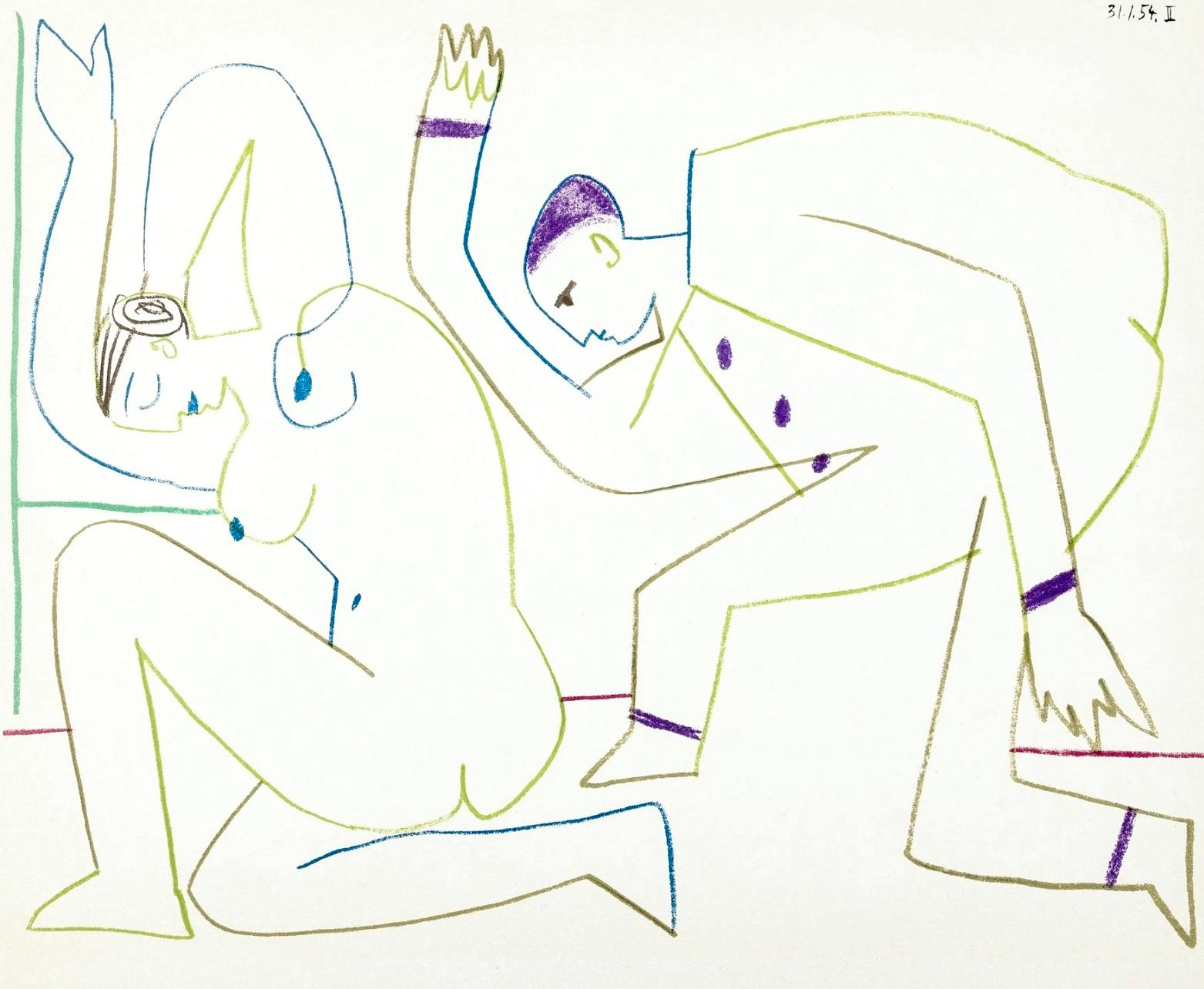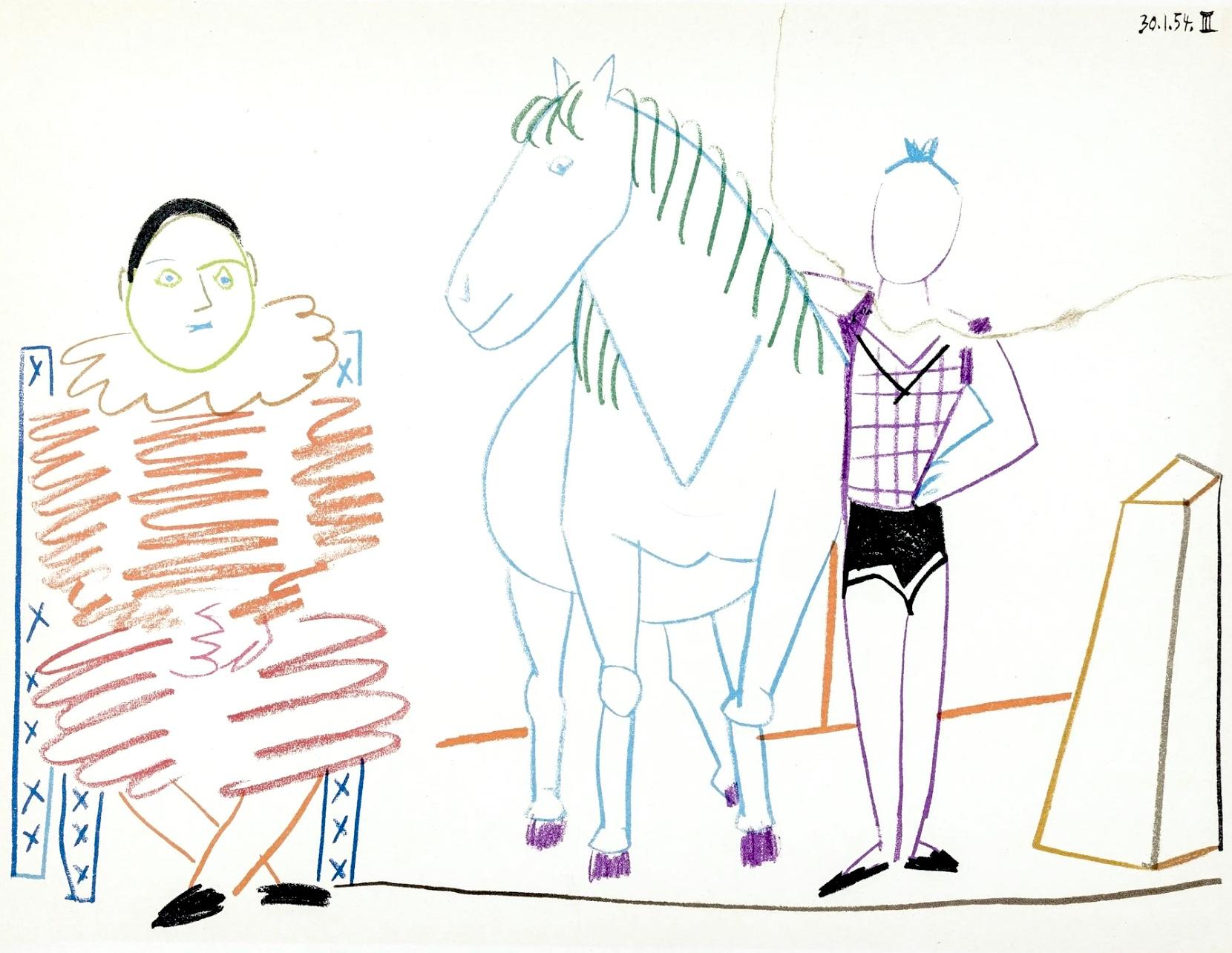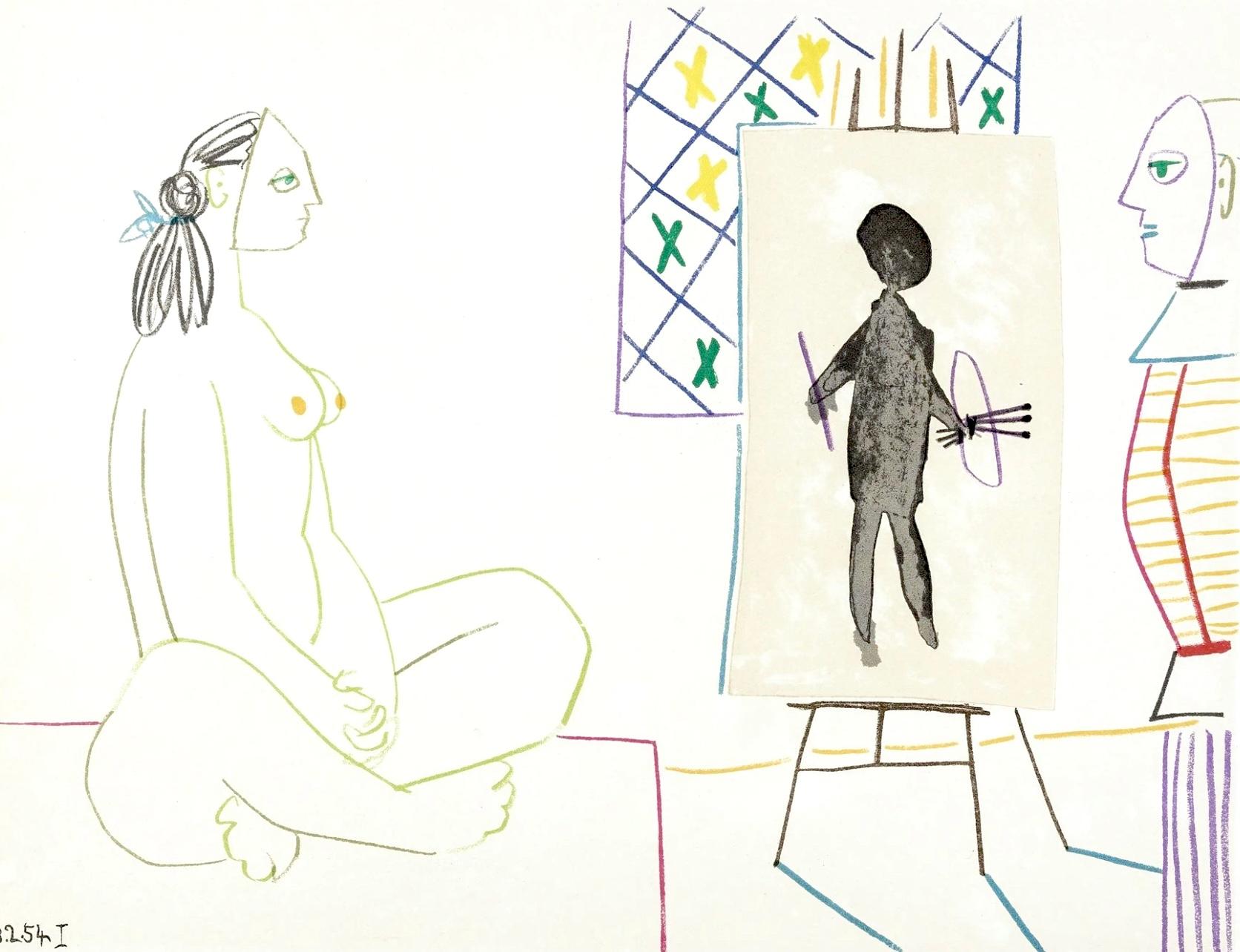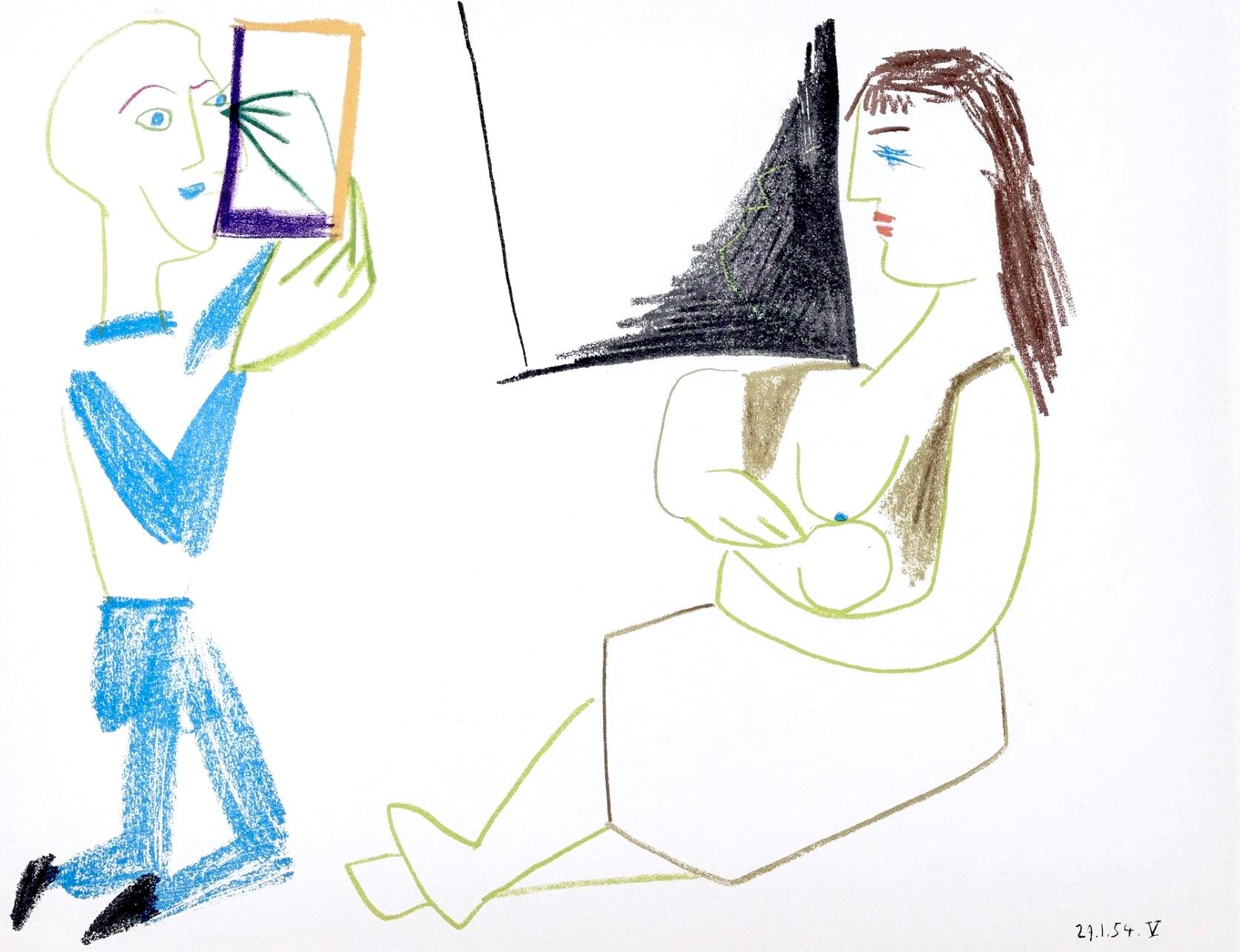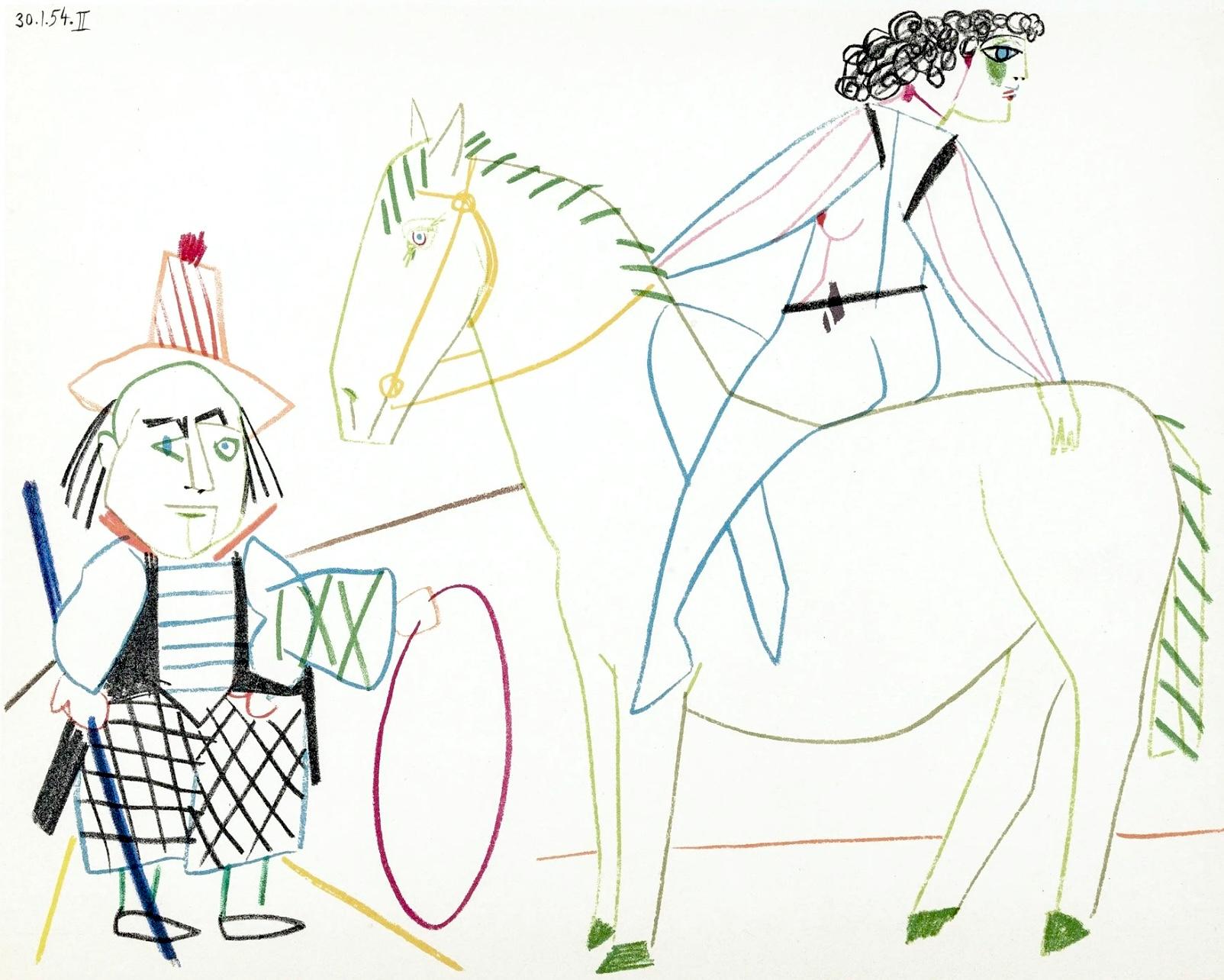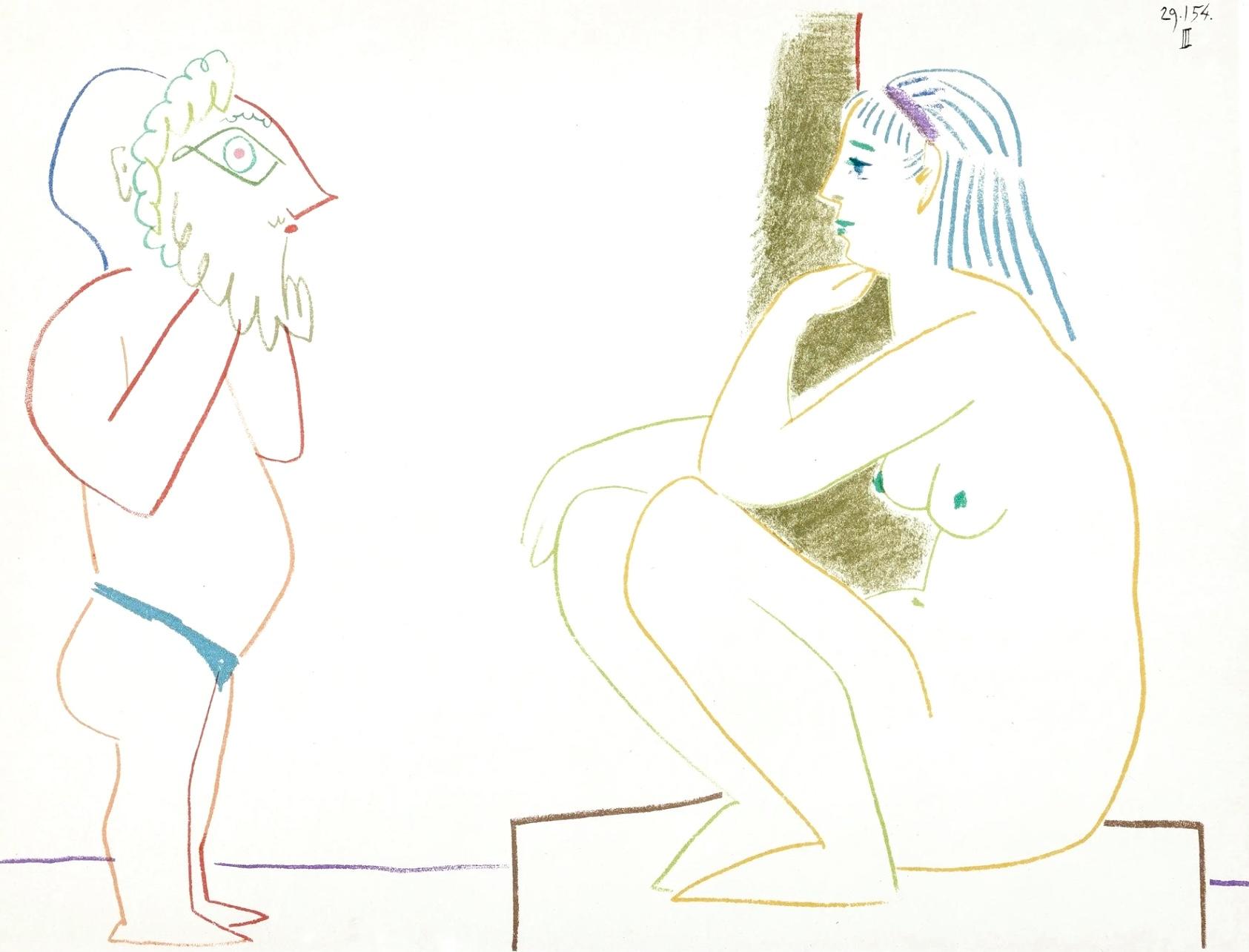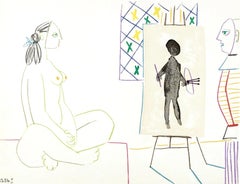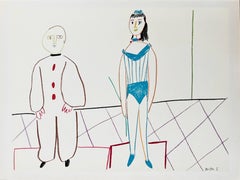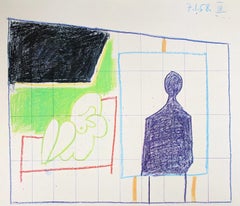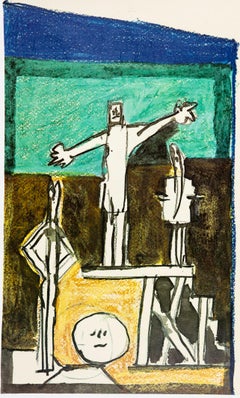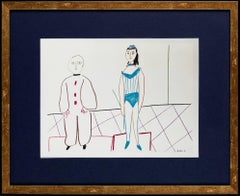Items Similar to Picasso, Composition, La Comédie Humaine, Verve: Revue Artistique (after)
Want more images or videos?
Request additional images or videos from the seller
1 of 11
Picasso, Composition, La Comédie Humaine, Verve: Revue Artistique (after)1954
1954
$956
$1,19520% Off
£723.28
£904.1020% Off
€834.78
€1,043.4720% Off
CA$1,335.27
CA$1,669.0820% Off
A$1,484.56
A$1,855.7020% Off
CHF 777.08
CHF 971.3520% Off
MX$18,207.65
MX$22,759.5620% Off
NOK 9,894.17
NOK 12,367.7120% Off
SEK 9,341.27
SEK 11,676.5820% Off
DKK 6,229.38
DKK 7,786.7220% Off
Shipping
Retrieving quote...The 1stDibs Promise:
Authenticity Guarantee,
Money-Back Guarantee,
24-Hour Cancellation
About the Item
Lithograph on vélin des Papeteries du Marais paper. Paper Size: 10.25 x 14 inches. Inscription: Unsigned and unnumbered, as issued. Notes: From the album, La Comédie Humaine, Suite de 15 dessins de Picasso, Verve: Revue Artistique et Littéraire, Vol. VIII, N° 29-30, 1954. Published by Éditions de la revue Verve, Paris, under the direction of Tériade, éditeur, Paris; printed by Mourlot frères, Paris, September 15, 1954 in an edition of MM. Excerpted from the album (translated from French), This double issue of Verve, dedicated to Picasso, whose cover was specially composed by the artist was completed to print on September 15, 1954 by the maîtres imprimeurs, Drager frères for the héliogravures, and Mourlot frères for the color lithographs. Excerpted from the publisher (translated from French), Last winter, from mid-December to the end of January 1954 Picasso was working indefatigably on this series of drawings, which rank among the finest, boldest, most poignantly human of all he has produced in the course of his long and brilliant career... Almost one could fancy that in his lonely nights at Vallauris these denizens of a world invented by himself crowded into the artist's room, sat for him, confessed unblushingly their most shameful secrets... We have published the series of drawings in its entirety. They form an organic whole, born of a surging uprush of the creative spirit, and to have omitted any of its elements would have been a mutilation. Nevertheless, when we isolate anyone of these elements and fix our attention on a single page, we find the fragment almost as eye-filling as the ensemble. All the drawings are reproduced in the exact size of the originals and in the chronological order of their making. Additional notes: Excerpted from Poppy Sfakianaki, ‘La revue Verve (1937–60): Un tremplin pour la carrière de Tériade dans les éditions d’art’, Journal of European Periodical Studies, 4.2 (Winter 2019), 70–89, In 1937, Tériade (1897-1983) met David Smart (1892-1952), the American publisher of Esquire magazine, who offered him to the opportunity to collaborate on the creation of 'the most beautiful magazine in the world'. Smart recognized in Tériade not only his ability as a publisher and knowledge of art history, but also his professional network and the name he made for himself in the Parisian art world—all crucial advantages for an editorial business. Having had the commercial conviction that beauty "sells", Smart intended to address the American public, attracted to French art, including Modern art, and the myth of artistic life in Paris. For his part, Tériade saw the proposed collaboration as an opportunity for a foray into the American market—a powerful ally of modern art in France. Éditions de la Revue Verve was founded in November 1937, largely funded by Smart, and directed by Tériade. Verve: Revue Artistique et Littéraire was a luxurious and ambitious art publication, published not only in French, but also in English in its early years, and distributed in Europe and the United States. Its configuration was reminiscent of that of the French art journals Cahiers d'art, Minotaure, and Arts et métiers graphiques, as well as that of the American art magazine, Coronet. However, Verve was superior to the competition because of its copious iconography and high printing quality. Its price varied between 60 and 150 francs (for double numbers) before the war, and between 120 and 350 francs during the war. Given its high price, the magazine mainly targeted art dealers, collectors, bibliophiles and wealthy art lovers. The exquisite aesthetics of the magazine was due to its editor-in-chief, Tériade, who sought to develop a platform for dialogue between image and text, visual arts and literature. The dominant factor of each issue remains its iconography, composed of reproductions of works by modern artists that Tériade admired, and 'masters', mainly of the French tradition, alongside photos and miniatures of medieval manuscripts. Tériade undoubtedly realized with his magazine an idea expressed in 1934 according to which books served as an 'ideal museum' or an exhibition where all the artistic masterpieces are gathered, which Malraux developed later in Le Musée imaginaire (Geneva: Skira, 1947), parts of which will appeared in Verve. During Second World War the periodicity of the journal changed, then irregular, and the less varied nature of the subjects treated. Thus, the issues published during the War (as well as in 1945 and 1946) were devoted exclusively to the reproduction of medieval illuminations. Finally, the special issues of the post-war period each present the recent production of a modern art painter. Only numbers 8 (1940) and 27-28 (1952) were an exception with a more varied summary. Verve's reception was positive as evidenced by several laudatory press articles throughout its run. The success of the magazine, Tériade's passion for modern art and medieval manuscripts, his admiration for the publications of Ambroise Vollard and Albert Skira, and his knowledge of the world of bibliophiles, soon led him to amplify his editorial activity. In 1943, despite the practical difficulties imposed by the war, his first artist's book was published, written and illustrated by Georges Rouault. Until 1975, Tériade published Éditions de la Revue Verve, nine books by modern artists, such as Henri Matisse, Pablo Picasso, Marc Chagall, Joan Miró, entirely composed (text and images) by the artists; seventeen books illustrated by recognized modern artists; an album of lithographs by Fernand Léger on Paris; two photographic albums by Henri Cartier-Bresson; two monographs on the artists André Beaudin and Francisco Borès; a luxurious series of reproductions of medieval illuminations; and, a series of portfolios on great French architecture. Ultimately, the comparative study of the journal and the editions of Verve: Revue Artistique et Littéraire illustrates the importance of the tacit relational dynamic that results from the relations of collaboration and exchange of symbolic capital based on common perceptions and interests, as well as on feelings of mutual friendship and appreciation of actors in the art world who share a visual and bibliophilic culture and thus contribute to the success of the journal and the publishing house.
PABLO PICASSO (1881-1973) was a Spanish painter, sculptor, printmaker, ceramicist, and theatre designer who spent most of his adult life in France. One of the most influential artists of the 20th century, he is known for co-founding the Cubist movement, the invention of constructed sculpture, the co-invention of collage, and for the wide variety of styles that he helped develop and explore. Among his most famous works are the proto-Cubist Les Demoiselles d'Avignon (1907) and the anti-war painting Guernica (1937), a dramatic portrayal of the bombing of Guernica by German and Italian air forces during the Spanish Civil War. Exceptionally prolific throughout the course of his long life, Picasso achieved universal renown and immense fortune for his revolutionary artistic accomplishments, and became one of the best-known figures in 20th-century art.
- Creation Year:1954
- Dimensions:Height: 10.25 in (26.04 cm)Width: 14 in (35.56 cm)
- Medium:
- Movement & Style:
- After:Pablo Picasso (1881-1973, Spanish)
- Period:
- Condition:
- Gallery Location:Auburn Hills, MI
- Reference Number:1stDibs: LU1465216380672
About the Seller
4.9
Platinum Seller
Premium sellers with a 4.7+ rating and 24-hour response times
Established in 1978
1stDibs seller since 2021
1,140 sales on 1stDibs
Typical response time: <1 hour
- ShippingRetrieving quote...Shipping from: Auburn Hills, MI
- Return Policy
Authenticity Guarantee
In the unlikely event there’s an issue with an item’s authenticity, contact us within 1 year for a full refund. DetailsMoney-Back Guarantee
If your item is not as described, is damaged in transit, or does not arrive, contact us within 7 days for a full refund. Details24-Hour Cancellation
You have a 24-hour grace period in which to reconsider your purchase, with no questions asked.Vetted Professional Sellers
Our world-class sellers must adhere to strict standards for service and quality, maintaining the integrity of our listings.Price-Match Guarantee
If you find that a seller listed the same item for a lower price elsewhere, we’ll match it.Trusted Global Delivery
Our best-in-class carrier network provides specialized shipping options worldwide, including custom delivery.More From This Seller
View AllPicasso, Composition, La Comédie Humaine, Verve: Revue Artistique (after)
By Pablo Picasso
Located in Auburn Hills, MI
Lithograph on vélin des Papeteries du Marais paper. Paper Size: 10.25 x 14 inches. Inscription: Unsigned and unnumbered, as issued. Notes: From the album, La Comédie Humaine, Suite d...
Category
1950s Cubist Abstract Prints
Materials
Lithograph
$956 Sale Price
20% Off
Free Shipping
Picasso, Composition, La Comédie Humaine, Verve: Revue Artistique (after)
By Pablo Picasso
Located in Auburn Hills, MI
Lithograph on vélin des Papeteries du Marais paper. Paper Size: 10.25 x 14 inches. Inscription: Unsigned and unnumbered, as issued. Notes: From the album, La Comédie Humaine, Suite d...
Category
1950s Cubist Abstract Prints
Materials
Lithograph
$956 Sale Price
20% Off
Free Shipping
Picasso, Composition, La Comédie Humaine, Verve: Revue Artistique (after)
By Pablo Picasso
Located in Auburn Hills, MI
Lithograph on vélin des Papeteries du Marais paper. Paper Size: 10.25 x 14 inches. Inscription: Unsigned and unnumbered, as issued. Notes: From the album, La Comédie Humaine, Suite d...
Category
1950s Cubist Abstract Prints
Materials
Lithograph
$956 Sale Price
20% Off
Free Shipping
Picasso, Composition, La Comédie Humaine, Verve: Revue Artistique (after)
By Pablo Picasso
Located in Auburn Hills, MI
Lithograph on vélin des Papeteries du Marais paper. Paper Size: 10.25 x 14 inches. Inscription: Unsigned and unnumbered, as issued. Notes: From the album, La Comédie Humaine, Suite d...
Category
1950s Cubist Abstract Prints
Materials
Lithograph
$956 Sale Price
20% Off
Free Shipping
Picasso, Composition, La Comédie Humaine, Verve: Revue Artistique (after)
By Pablo Picasso
Located in Auburn Hills, MI
Lithograph on vélin des Papeteries du Marais paper. Paper Size: 10.25 x 14 inches. Inscription: Unsigned and unnumbered, as issued. Notes: From the album, La Comédie Humaine, Suite d...
Category
1950s Cubist Abstract Prints
Materials
Lithograph
$956 Sale Price
20% Off
Free Shipping
Picasso, Composition, La Comédie Humaine, Verve: Revue Artistique (after)
By Pablo Picasso
Located in Auburn Hills, MI
Lithograph on vélin des Papeteries du Marais paper. Paper Size: 10.25 x 14 inches. Inscription: Unsigned and unnumbered, as issued. Notes: From the album, La Comédie Humaine, Suite d...
Category
1950s Cubist Abstract Prints
Materials
Lithograph
$956 Sale Price
20% Off
Free Shipping
You May Also Like
La Comédie Humaine
By Pablo Picasso
Located in OPOLE, PL
Pablo Picasso (1881-1973) - La Comédie Humaine
Lithograph from 1954.
Dimensions of work: 35.5 x 26.5 cm
Publisher: Tériade, Paris.
The work is in Excellent condition.
Fast and s...
Category
1950s Modern Figurative Prints
Materials
Lithograph
Picasso, Composition (Cramer 155), Pablo Picasso, La Chute D'Icare (after)
By Pablo Picasso
Located in Fairfield, CT
Medium: Lithograph on vélin paper
Year: 1972
Paper Size: 20.5 X 26.4 inches
Catalogue raisonné reference: Cramer, illustration 155
Inscription: Inscription: Unsigned and unnumbered, as issued
Notes: From the folio, Pablo Picasso, La Chute D'Icare, Décoration du Foyer des Délégués
Palais de l'UNESCO à Paris, Suite d'études préparatoires en noir et en couleurs réalisées du 6 décembre 1957 au 29 janvier 1958, 1972. Published by Albert Skira, Éditeur, Genève; printed by Roto-Sadag S.A. Genève, December 20, 1972. Excerpted from the folio (translated from French), This album contains the series of preparatory tests in black and VII color studies, reproduced, made by Pablo Picasso for the decoration of the home of the delegates at the Palais de l'UNESCO in Paris, was completed to print on December 20, 1972 on the presses of Imprimeries Roto-Sadag S.A. and Atar S.A. in Genève. The edition of this album is as follows: CXXV examples numbered from I to CXXV, XXV examples, out of commerce, numbered H.C. I to XXV, reserved for the artist and the publisher. Each of these albums contains an etching by Pablo Picasso, signed and numbered...
Category
1970s Cubist Figurative Prints
Materials
Lithograph
$956 Sale Price
20% Off
Picasso, Composition (Cramer 155), Pablo Picasso, La Chute D'Icare (after)
By Pablo Picasso
Located in Fairfield, CT
Medium: Lithograph on vélin paper
Year: 1972
Paper Size: 15.875 X 11.75 inches
Catalogue raisonné reference: Cramer, illustration 155
Inscription: Inscription: Unsigned and unnumbered, as issued
Notes: From the folio, Pablo Picasso, La Chute D'Icare, Décoration du Foyer des Délégués
Palais de l'UNESCO à Paris, Suite d'études préparatoires en noir et en couleurs réalisées du 6 décembre 1957 au 29 janvier 1958, 1972. Published by Albert Skira, Éditeur, Genève; printed by Roto-Sadag S.A. Genève, December 20, 1972. Excerpted from the folio (translated from French), This album contains the series of preparatory tests in black and VII color studies, reproduced, made by Pablo Picasso for the decoration of the home of the delegates at the Palais de l'UNESCO in Paris, was completed to print on December 20, 1972 on the presses of Imprimeries Roto-Sadag S.A. and Atar S.A. in Genève. The edition of this album is as follows: CXXV examples numbered from I to CXXV, XXV examples, out of commerce, numbered H.C. I to XXV, reserved for the artist and the publisher. Each of these albums contains an etching by Pablo Picasso, signed and numbered...
Category
1970s Cubist Figurative Prints
Materials
Lithograph
$956 Sale Price
20% Off
La Comédie Humaine
By Pablo Picasso
Located in OPOLE, PL
Pablo Picasso (1881-1973) - La Comédie Humaine
Lithograph from 1954.
Dimensions of work: 35.5 x 26.5 cm
Publisher: Tériade, Paris.
The work is in Excellent condition.
Fast and s...
Category
1950s Modern Figurative Prints
Materials
Lithograph
Picasso, Composition (Cramer 84), Picasso en marge du Buffon (after)
By Pablo Picasso
Located in Fairfield, CT
Medium: Lithograph on vélin du Marais paper
Year: 1957
Paper Size: 14.5 x 11 inches
Catalogue raisonné reference: Cramer, illustration 84
Inscription: Inscription: Unsigned and unnum...
Category
1950s Cubist Figurative Prints
Materials
Lithograph
$956 Sale Price
20% Off
Picasso, Composition (Cramer 84), Picasso en marge du Buffon (after)
By Pablo Picasso
Located in Fairfield, CT
Medium: Lithograph on vélin du Marais paper
Year: 1957
Paper Size: 14.5 x 11 inches
Catalogue raisonné reference: Cramer, illustration 84
Inscription: Inscription: Unsigned and unnum...
Category
1950s Cubist Figurative Prints
Materials
Lithograph
$956 Sale Price
20% Off
More Ways To Browse
Vallauris Picasso
David Winter Sculptures
Pablo Picasso Vollard Suite
Picasso La Comedie Humaine
Journal Des Demoiselles
Luciano Castelli
Manoela Madera
Matisse Decoupage
Matsutani Takesada
Milan Lukac
Moore Of Bedford
Noemi Gerstein
Patricia Rodriguez
Rene Lubarow
Richard Whalen
Robert Motherwell Paris Suite
Salvador Dali Mary
Steinberg Galerie Maeght Poster
